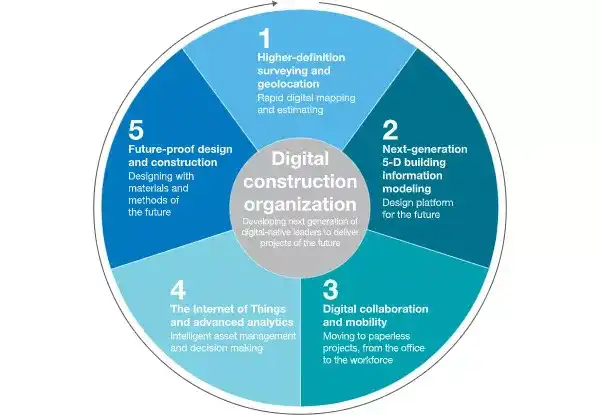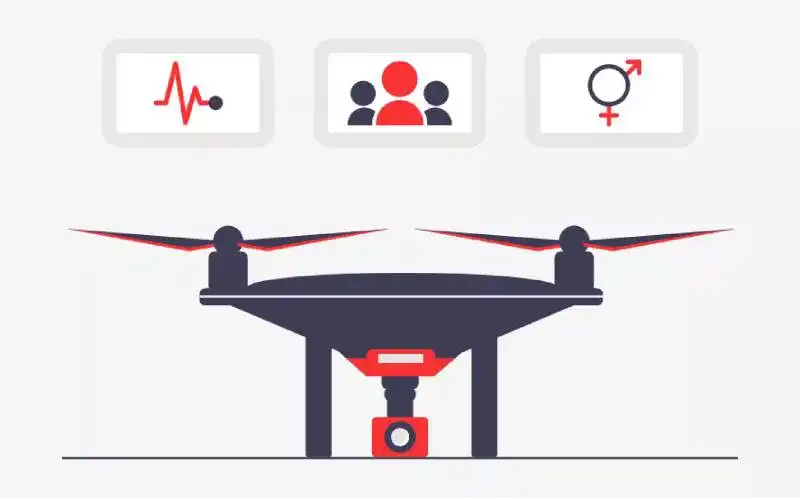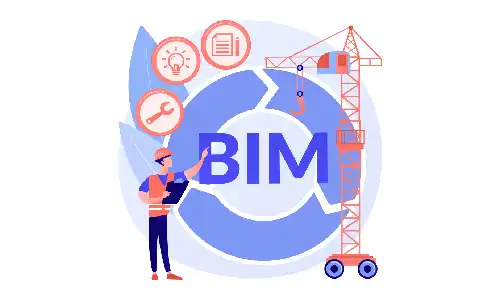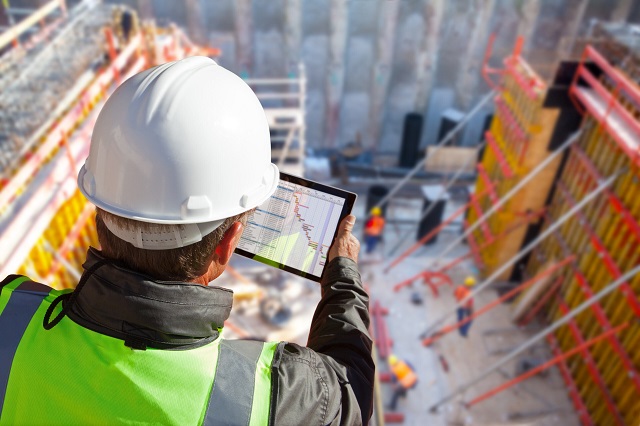The introduction of technological advancements is paving the way for digital transformation in the construction industry.
Today, there are countless examples of how technology is transforming this industry today.
Emerging technologies like Artificial Intelligence (AI) and the Internet of Things (IoT) are assisting construction companies in eliminating inefficiencies and low productivity that have existed for a long time.
It’s critical for construction companies to keep up with the newest technological developments in the industry.
In this article, we’ll look at some of the most fascinating construction technology innovations in 2022.
But first, let’s look at what’s driving the construction industry’s digitization.
Why is the Traditional Brick-and-Mortar Industry Reshaping?
So, why is our conventional brick-and-mortar sector evolving at such a rapid pace?
It’s fascinating to learn about the variables that are causing the shift.

The construction sector and technology complement one other in various ways, including:
1. Rapidly changing client expectations
Clients are well aware of the market’s quick changes.
They are demanding more innovatively designed products for their homes, workplaces, commercial buildings, and other locations. Client expectations are rapidly rising.
As a result, structures will be more modularized, specialized, and energy-efficient, with increased security and health criteria.
2. Powerful capacities in technology
In the construction industry, new opportunities have emerged. Sensors, hardware, and software usage is becoming much more inexpensive while enhancing efficiency.
Construction professionals should expect more new and beneficial transformations as a result of technological advancements such as augmented reality and virtual reality (AR/VR), drones, robots, and additive printing.
3. Burgeoning start-up environment
Start-ups are increasingly making meaningful contributions as a result of new market opportunities created by technological advancements.
Since 2010, Oliver Wyman, a global management consulting firm, has identified over 1,200 real estate and construction start-ups that have garnered over US$19.4 billion in investment.
4. Emerging techies and new-gen craftsmen
You may be aware, as construction professionals, that the business is rife with opposition to change.
So, what’s new is the tech-savvy of construction experts who are adopting digital tools and fashionable design concepts. With new tech-related occupations on the horizon, the younger generation has a decade ahead of them to apply creativity to procedures.
5. Supportive legal frameworks
With digitalization, there is a huge chance to reduce building projects’ environmental effect, which is in line with governments’ growing CO2 and energy efficiency laws.
In buildings and infrastructures, there will be more stringent data usage and cybersecurity standards.
As a construction entrepreneur, you will find that the decade of creating opportunities for innovation laboratories to supplement experiences to a new wave of possibilities, assuring industry success.
So, what are the digital construction technology trends for 2022? Let’s have a look.
Top Trends That Will Influence Construction Technology
Before we dive into the details of digital technology trends in construction in 2022 with examples, let’s take a sneak peek at some top trends that you can expect as influencers in construction technology.
Here are some key influences, according to the McKinsey analysis.

1. HD Surveying and Geolocation
Projects are frequently delayed due to differences in ground conditions.
High-definition photography, 3-D laser scanning, geographic information systems, and other new approaches can help enhance accuracy and speed.
2. 5-D Building Information Modeling (BIM)
BIM is a digital representation of a project’s features, including physical and functional elements, that serves as a trustworthy foundation for making choices throughout its life cycle.
Augmented reality (AR) technology via wearable devices may be further advanced with the usage of 5-D BIM technology, which will revolutionize the construction sector.
3. Digital Collaboration and Mobility
The advantages of digitizing processes are numerous.
Construction digital solutions must provide a seamless real-time experience across several elements, including design management, materials management, scheduling, quality control, crew tracking, and more.
4. IoT and Advanced Analytics
In the construction industry, the IoT can allow construction machinery, equipment, materials, structures, and more to talk to a central data platform.
Sensors and near-field communication (NFC) devices, among other technologies, can monitor productivity and dependability.
5. Future-proof Design and Construction
The worldwide building materials market is worth $1 trillion. Aerogels, self-healing concrete, and nanoparticles are examples of new building materials that can reduce construction costs while also enhancing quality and safety.
As a construction professional, you’re probably curious in how to successfully adapt construction processes using new technology trends.
As CEO of Arabian Construction Company Maher Merehbi says:
“In construction, innovations, and improvements are dynamic and happen quite frequently.”
As a result, you may anticipate adopting cutting-edge technology, and the McKinsey research has already identified some of the most intriguing emerging technologies.
Here’s a look at some of the digital technology developments that will affect the construction sector in 2022, along with some examples.
Construction Technology Trends: 7 Futuristic Ideas & Examples

1. Augmented Reality (AR)
In the construction industry, augmented reality and virtual reality are at a fork in the road.
While AR superimposes a computer-generated picture over a user’s perspective of the world, VR uses a virtual environment to replace the actual one.
In the construction industry, however, AR is swiftly overtaking VR as an emerging trend due to its benefits and applications.
Consider the impact of viewing the real world via the lens of a camera. While the user can look at components or see display warnings when there are hazards close, AR systems may display essential information about equipment while the user can look at components or see display warnings when there are risks nearby.
For example, the user can get alerts through the AR lens that can signal surfaces, which are at high temperatures or electrically charged.
As buildings are becoming increasingly complex, both AR and VR can facilitate in detecting design and coordination errors.
AR can also present BIM data through a next-generation visual platform, which could help in fostering coordination between consultants, designers, and construction teams. So, AR can also be used to discuss projects with clients.
For example, if you have a vacant site, then a completed project can be overlaid on the empty site so that the client can visualize the final result.
Construction professionals can look at new opportunities for the industry, even though they could come at a cost.
2. Building Information Modelling (BIM)

Another popular construction technology trend is BIM, which promises to improve building accuracy.
With its capacity to show project progress in an open and highly collaborative environment, BIM will prove to be a game-changer for the construction sector.
Construction businesses may profit from the technology in a number of ways. It facilitates resource management, allows for improved cooperation, and keeps individuals in touch throughout the project.
Budget overspending, QC difficulties, and project delays are all concerns that the new technology may help with. You may come across the newest version, known as 5D BIM, which offers quicker project cycles, a better grasp of project scope, and increased productivity.
The Dubai-based architecture company Killa Design, which has been a pioneer behind some of Dubai’s most famous projects, such as the Museum of the Future, has adopted the technology.
Autodesk BIM 360, Revit, Navisworks, Tekla BIMsight, BIMobject, and BIMx are among the major BIM software options available in 2022.
Higher levels of BIM usage will be seen in the industrialization of building in 2022.
3. Robotics
Don’t be shocked if you see robots at your place of business! No, it wouldn’t be a science fiction story—rather, it would be an unavoidable fact.
With their precision and accuracy, robots are expected to become a dominant force in the construction industry. The initial cost of robots may be significant, but the rewards will be well worth it.
For example, you may witness robots laying bricks and tying rebar or completing man-operated construction projects.
With various types of robots, such as collaborative industrial robots and logistics robots, you can expect more extensive adoption of robotics in construction. So, get ready to embrace robots as they assist in tasks that would take a human worker more effort.
For example, robots lifting heavy objects and placing them in exact coordinates.
4. More Prefabrication, Modularization, and Eco-friendliness
Multi-trade prefabrication is becoming increasingly popular.
In Dubai, for example, construction experts produced a 3D office structure in 17 days and assembled it in two days on-site. Prefabrication is expected to save you money. You can get bulk savings on materials as a construction expert.
Another advantage is that it saves time. Professionals have employed prefabrication on some of the UAE’s most outstanding buildings, such as the Dubai Mall and Dubai Opera, because of its benefits.
Off-site building, often known as modularization or prefabrication, is another intriguing development. With its promise of uniform quality and shorter construction timelines, the technology has the potential to generate structures that are comparable to those constructed traditionally.
Another outstanding example is a two-day precast house, which aligns with the Saudi Arabian government’s increased attempts to expedite innovation and encourage homeownership in the nation. A local business utilized modular concrete to construct the property (one-story) in Riyadh.
As a result, forward-thinking construction firms have already begun using these tactics in their operations. The new technology’s uniformity aids in the reduction of prices and lead times.
These approaches also have the added bonus of being environmentally beneficial, since any surplus materials used during construction may be simply recycled.
5. Self-healing Concrete
Self-healing concrete is expected to be utilized on buildings, roadways, and residences by 2022.
Consider how new technologies may be used to address issues like structural degradation and building flaws. Although the technology is still in its infancy, it has the potential to be a great solution to such problems.
Concrete is the most frequently manufactured and used material in the building sector, and many experts predict that it will be utilized in the amount of 5 billion metric tons per year by 2030.
6. Cloud and Mobile Technology
Many sectors have already used cloud operating systems. You may now store enormous quantities of data and share it immediately using mobile devices that leverage cloud technologies (anywhere, anytime).
As a result, you may discover that you need to adopt a cloud-based company phone system that is conveniently accessible in order to stay competitive.
Cloud solutions can help project managers not only store vast volumes of data, but also make it available to them while keeping it safe in a remote location. Later, linked devices or data analysis tools can access this information.
So, while powerful data processing and storage are just two of the advantages of cloud computing technology, the latter can be crucial for businesses to satisfy contractual responsibilities.
Cloud-based Collaborations in Construction Projects
Cloud-based Collaboration will be another major trend in 2022. Communication is essential to the effective completion of any project, and construction projects are no exception.
With increased fragmentation in construction projects and little or no synchronization amongst teams, cloud-based collaboration solutions are expected to bridge the gap effectively.
With several project participants and teams located throughout the globe, it’s clear that project complexity rises, and efficient project team cooperation becomes critical to success.
According to a poll, 87 percent of the construction sector said they were willing to use cloud technology to streamline their procedures.
Developers, engineers, and contractors will be able to effortlessly integrate and manage their existing processes through a single, always-connected cloud-based platform by 2022. You may also seek for real-time collaboration via cloud-based collaborations.
Contractors can use the cloud to collaborate on the same data sets throughout the back office. You’ll also discover projects running in real-time with correct data and digitalization, reducing manual activities, saving time, increasing cost flexibility, and increasing profitability and productivity.
7. Drones
Drone technology is quickly developing, and many construction sites rely significantly on drones (a.k.a. unmanned aerial vehicles, UAVs).
Business and government investment in drone technology is expected to exceed $13 billion by 2021, according to Goldman Sachs. By 2025, the commercial development of drones is expected to reach over $10.9 billion.
In 2021, the drone business is expected to be worth $11.2 billion.
Drones may help in the construction industry in a variety of ways.
Surveyors, for example, can inspect a site in a matter of minutes, compared to weeks or even months in the past. With the benefits of saving time and money, as well as accuracy and precision, more construction enterprises will adopt technology.
Another great example is the Abu Dhabi Municipality in the United Arab Emirates, which launched a trial program to employ drones to monitor engineering work on construction projects.
The system will assess the drone’s capacity to resist extreme weather conditions, which will aid in the identification of technological solutions to assist activities on the ground.
In 2022, the construction sector will see some fantastic digital solutions, so get ready to keep up with the current trends and enjoy surfing the waves of change.
An Experienced Technology Partner for Incorporating Digital Technology Trends
It’s fantastic that you’re looking for cutting-edge digital technology solutions in your construction operations as building experts.
We can assist you with implementing superior digital technology solutions to help you keep ahead of the competition and provide a consistent experience while saving you time and money.
We are a multi-award-winning team of online and mobile application developers with extensive knowledge in new technologies such as artificial intelligence and the Internet of Things.
Got A New Project?
Book a meeting with one of our team members or get a ball park estimation on your project.
Book A MeetingGet A Rough EstimateFrequently Asked Questions
1. Top Techniques That Will Influence Construction Technology
- HD Surveying and Geolocation
Projects typically get delayed because of discrepancies in ground conditions.
New techniques that incorporate high-definition photography, 3-D laser scanning, and geographic information systems, and more can improve accuracy and speed.
- 5-D Building Information Modeling (BIM)
BIM is a digital representation of the characteristics, including physical and functional aspects of a project, which forms a reliable basis for decisions during the project’s life cycle.
With the use of 5-D BIM technology, augmented reality (AR) technology via wearable devices can be further enhanced, which will transform the construction industry
- Digital Collaboration and Mobility
Digitizing workflows have substantial benefits.
Digital solutions for construction need to deliver a seamless real-time experience across facets, such as design management, materials management, scheduling, QC, crew tracking, and more.
- IoT and Advanced Analytics
In the construction industry, the IoT can allow construction machinery, equipment, materials, structures, and more to talk to a central data platform.
Other technologies, including sensors and near-field-communication (NFC) devices, can monitor productivity and reliability.
- Future-proof Design and Construction
Building materials represent a $1 trillion global industry. With new building materials, such as aerogels, self-healing concrete, and nanomaterials, can lower costs and also speed up construction, improving quality and safety.
As a construction professional, you’d be interested in knowing how to transform the construction processes using new tech trends successfully.
2. Seven Futuristic Technology Trends for the Construction Industry
- Augmented Reality (AR)
Augmented reality and virtual reality are technologies that are making crossroads in the construction world. While AR superimposes a computer-generated image on a user’s view of the world, VR can replace the real world through a simulated environment. For example, the user can get alerts through the AR lens that can signal surfaces, which are at high temperatures or electrically charged.
- Building Information Modelling (BIM)
Another hot construction technology trend is BIM that promises to bring in more accuracy to the building process.
BIM will prove to be a game-changer for the construction industry with its ability to depict the project development in an open and highly collaborative environment.
The technology offers several benefits to construction companies, which makes resource management more accessible, enables enhanced collaboration, and helps people stay in touch throughout the project.
The new technology can facilitate in tackling challenges, including budget overspend, QC issues, and project delays. You may come across the latest version called the 5D BIM, which provides shorter project cycles, project scope understanding, and an increase in productivity.
For example, Leading names that have embraced the technology include the Dubai-based architectural firm Killa Design, who have been pioneers behind some of Dubai’s most iconic buildings, such as the Museum of the Future.
- Robotics
Don’t be surprised if you find robots showing up at your worksites! No, it would not be a sci-fi plot—but an inevitable reality.
You can expect robots to become a commanding force in the construction arena with its offering of precision and accuracy. The cost of robotics may be high at the beginning, but it will be well worth the benefits.
For example, you may witness robots laying bricks and tying rebar or completing man-operated construction projects.
- More Prefabrication, Modularization, and Eco-friendliness
You will witness a growing trend towards multi-trade prefabrication.
For example, In Dubai, construction professionals printed a 3D office building in around 17 days and spent two days on-site assembling it. You can expect prefabrication to save you money. As construction professionals, you can benefit from bulk discounts on materials.
- Self-healing Concrete
In 2020, you can expect to see self-healing concrete used on buildings, roads, and homes.
Imagine the use of new technology to work on concern areas such as structural deterioration and building cracks. Although, at a nascent stage, the technology could be an excellent solution for such pain points.
- Cloud and Mobile Technology
Cloud operating systems have already been in use in many industries. Today, with mobile devices leveraging cloud technology (anywhere, anytime), you can look forward to storing massive amounts of information, and sharing it instantly.
So, to remain competitive, you may find the need to use a cloud-based business phone system that can easily be accessible.
Cloud solutions can not only facilitate storing large amounts of data but also in making it accessible for project managers, keeping it secure in a remote location. Later, this information can be accessed by connected devices or by data analysis platforms.
- Drones
Drone technology is rapidly evolving, and many construction sites are heavily relying on the use of drones (a.k.a. unmanned aerial vehicles, UAVs).
For example, surveyors can survey a site in a fraction of minutes, which traditionally can take weeks or even months. With the advantage of saving time and money, and accuracy and precision, you will find more construction companies who will openly embrace the technology.
Related Articles
Translating innovation to sustainable business growth.
Let’s Work Together to Create the Future We Want
WDX Technologies helps businesses turn their ideas into successful digital realities. We excel in creating digital solutions that solve critical pain points while making you and your customers the HERO.


